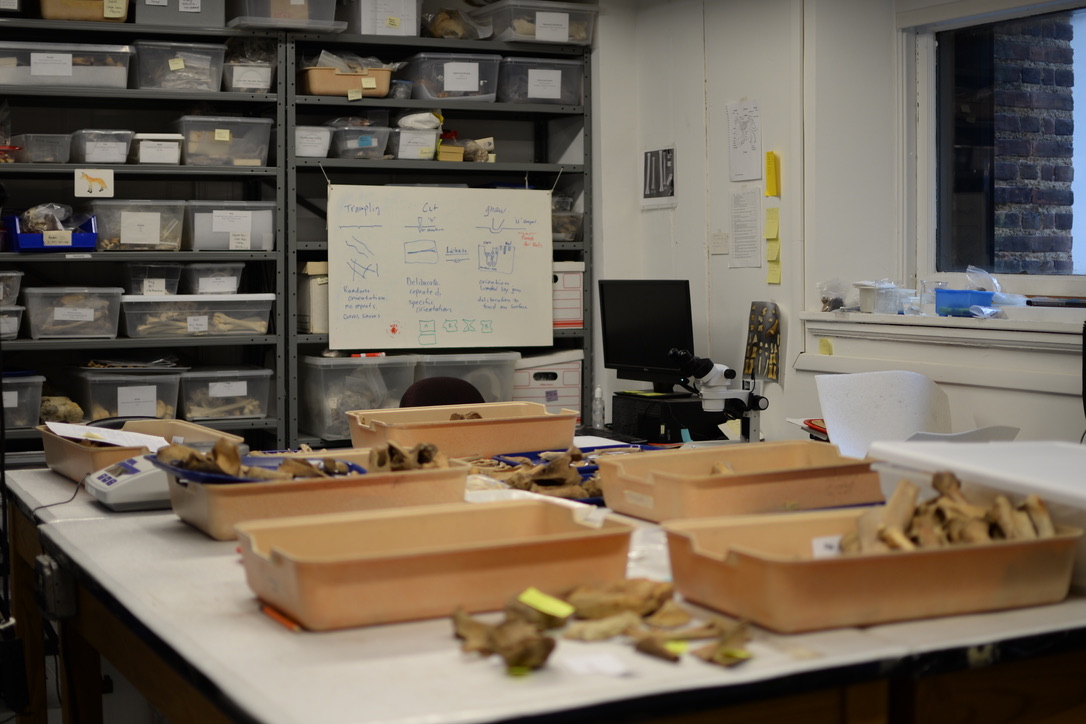Zooarchaeology Laboratory
Led by Dr. Katherine Moore | Email: caam@pennmuseum.org

Research in the Zooarchaeology Laboratory examines the relationship between humans and animals. We are interested in the animals people used for food, work, and pets in the recent and distant past; we also seek to sort out the understand the impact of changing climates and economies on health and disease.
The Zooarchaeology Laboratory began as a small collection of skeletons from the Penn veterinary school assembled in the 1960s to help identify animal bones from archaeological sites in the Near East. Formally organized by the late Kathleen Ryan for MASCA, the collection comprised 61 specimens in 2013 when it was absorbed into the teaching and research work of CAAM. We now hold more than 600 skeletons, partial skeletons, mollusks, and crustaceans. In addition, we are grateful to the Academy of Sciences of Philadelphia for several key long term loans and to the University of Michigan for gifts of skeletal material. This material is arranged for teaching and research in Museum 160.
Current Research Projects
- Kitchen House Project
- Human Ecology of Early High Altitude Communities in South America
- Animals in the Historic Delaware Valley
- Zooarchaeology In Junin Peru, pilot restudy project, in collaboration with Kurt Rademaker
- Zooarchaeology and Craft Production, Taraco Archaeological Project, in collaboration with Christine Hastorf and others
- Fiber and craft production evidence, Uzüür Gyalan, Mongolia. (Kristen Pearson)
- Zooarchaeology of Anau depe, Turkmenistan, in collaboration with Fredrik Hiebert and Naomi Miller
- Use and Care of Dogs in Central America, craft production evidence (American Section, UPenn Museum)
- Zooarchaeology at Smith Creek, Mississippi (Oscar Aguila, Ashley Terry, Megan Kassabaum)
- Zooarchaeology of Foster Farm, Deer Isle Maine (Megan Postemski)
- comparative material with detailed anatomical labeling
- mounted specimens for teaching and classroom use
- experimental archive of taphonomic signatures from multiple agents and depositional settings, special emphasis on ravaging, burial diagenisis, food preparation and craft
- paleopathological specimens (modern and archaeological) sources, images and xrays
- histological thin sections and images for both bones and teeth
- teaching collection of non-bone specimens (mollusks, crustaceans, vertebrate soft tissues)
- published reference materials for anatomy, zooarchaeology, wildlife biology
Large mammal skeletons from wild and domestic species of Eurasia support Penn’s long term research goals on animal domestication and the study of animal use in emerging complex and urban societies in the Near East, Mediterranean, and Europe. Recently this collection has been expanded to cover work in the Andes of South America. Animal life history and herd composition is important in this work, so we are continually expanding the developmental diversity of our collections within these key species. This core collection may also be applied to regions where domesticated animals have entered as part of global colonialism. Additionally, we serve local archaeology in Eastern North America, both prehistoric and historic, with a collection of local mammals, birds, and fish.
- Low power incident light microscopes, USB microscopes for work with large specimens
- Calipers and digital scales for routine description
- Refrigerator and freezer for fresh specimens
- Equipment located in other CAAM and Conservation labs:
- X-ray radiography suite: GE Eresco 65 MF4 instrument with a GE-DXR 250V digital capture plate and GE Rhythm RT and Review software
- JEOL JCM-6000 Scanning Electron Microscope-Energy Dispersive X-Ray Spectroscopy (SEM-EDS)
- Extec Labcut 150 variable speed precision diamond saw
- Keyence VHX-5000 digital microscope with VH-Z20 and VH-Z100 lenses
- Keyence digital microscope
- Motic microscopes and Zeiss microscope and camera for thin section description and analysis
- X-ray suite
- Prep space and hood for cleaning and treating specimens
- SEM for imaging small-surface traces
We have extensive experience with archaeobiological sampling and recovery and collaborate with archaeobotanists in CAAM to demonstrate best practices in field recovery for a broad range of research goals, archaeological contexts and field conditions. We collaborate with the Conservation Department in dealing with challenging support and cleaning protocols for field recovery and storage. These materials can be applied to research on any time period and to any region of the world.
Legacy samples of zooarchaeological remains in the Museum include ones from Iran (Hasanlu, Hotu), and Turkey (selected seasons at Gordion). Sampling and Analysis status material in the lab includes samples from Turkmenistan, Philadelphia, New Jersey, Turkey, Italy, South Carolina (on loan), Mississippi (on loan), Bolivia (soon to be returned), and Peru (now returned). Though continued analysis of legacy collections is an important goal, it is unlikely that large samples will come to the Penn Museum again except from the United States. For this reason, training, imaging, analytical subsampling and intensive capacity building for work around the world are key to our mission. Our students are trained to apply methods to multiple areas in the world, deal with curatorial, biological and cultural heritage challenges, and to increase the scope and power of zooarchaeological research around the world.
- Living World in Archaeological Science – ANTH 2267, CLST 3303, NELC 2950, ANTH 5267, CLST 5303
- Archaeology of Animals – ANTH 3215, ANTH 5215
- Independent Studies
- Integrated course: Food & Fire: Archaeology in the Laboratory ANTH 1480, CLST 1302, NELC 0910
- CAAM Intensive Course Series: Methods for Zooarcheology

